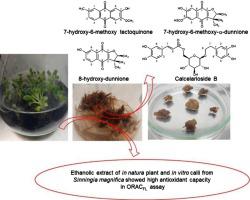Industrial Crops and Products ( IF 5.6 ) Pub Date : 2020-11-07 , DOI: 10.1016/j.indcrop.2020.113046 A.F. Serain , S.E.B. Silvério , C.C. De Lourenço , V.K. Nunes , W.R. Corrêa , M.E.A. Stefanello , M.J. Salvador

|
Quinones and phenolic glycosides display several biological activities and has been reported in Sinningia species (Gesneriaceae family). The plant tissue culture technique is an excellent tool for metabolism process studies and metabolites extraction. The aim of this work was the callogenesis induction and the secondary callus culture optimization in Sinningia magnifica (Otto & A. Dietr.) Wiehler, varying different types and concentrations of growth regulators, light, antioxidant, and culture medium. These conditions may influence the potential and the morphology of the induced callus, and thus the production and variation of secondary metabolites. Our studies found that for S. magnifica, the best method was fixed using Murashige and Skoog medium culture, in the absence of light, at a concentration of 8.0 mgL−1 of 6-Benzylaminopurine and of 2,4-dichlorophenoxyacetic acid, with a callus development reaching a plateau in about 45 days. The potent antioxidant activity of calli was compared with the in natura plant and demonstrated the greater variety of secondary metabolites. 7-hydroxy-6-methoxy-tectoquinone and 7-hydroxy-6-methoxy-α-dunnione were found in higher quantities in in vitro plants culture compared with the in natura plant, demonstrating the importance of using other methods in order to improve the secondary metabolites production and the advantages of this source for bioactive compounds development and exploitation.
中文翻译:

开发用于体外生产醌和生物活性分子的Sinningia magnifica(Otto&A. Dietr。)Wiehler(Gesneriaceae)组织培养物
醌和酚类糖苷显示出几种生物学活性,并且已在Sinningia物种(Gesneriaceae家族)中报道。植物组织培养技术是代谢过程研究和代谢产物提取的极佳工具。这项工作的目的是在Sinningia magnifica(Otto&A. Dietr。)Wiehler中进行愈伤组织的诱导和二次愈伤组织培养的优化,改变生长调节剂,光,抗氧化剂和培养基的不同类型和浓度。这些条件可能会影响诱导愈伤组织的潜力和形态,从而影响次生代谢产物的产生和变化。我们的研究发现,对于S. magnifica最好的方法是使用Murashige和Skoog培养基进行培养,在无光照的情况下,浓度为8.0 mgL -1的6-苄基氨基嘌呤和2,4-二氯苯氧基乙酸,愈伤组织发育在约45天。将愈伤组织的有效抗氧化活性与天然植物进行了比较,证明了次生代谢产物种类更多。7-羟基-6-甲氧基tectoquinone和7-羟基-6-甲氧基- α-dunnione在较高量被发现在体外植物培养与相比于NATURA 证明了使用其他方法改善次生代谢产物生产的重要性,以及该来源对生物活性化合物开发和利用的优势。











































 京公网安备 11010802027423号
京公网安备 11010802027423号